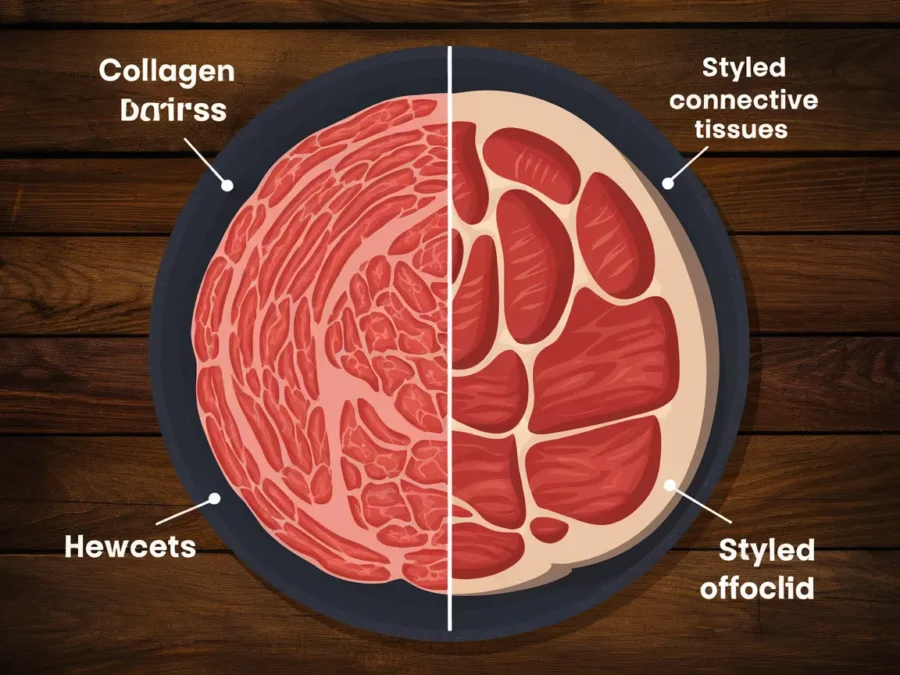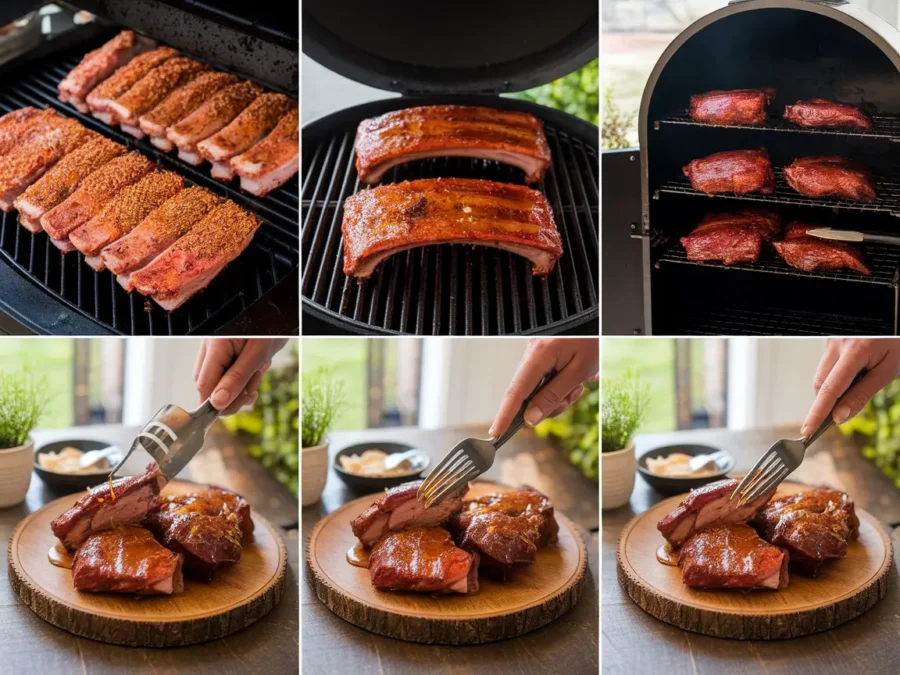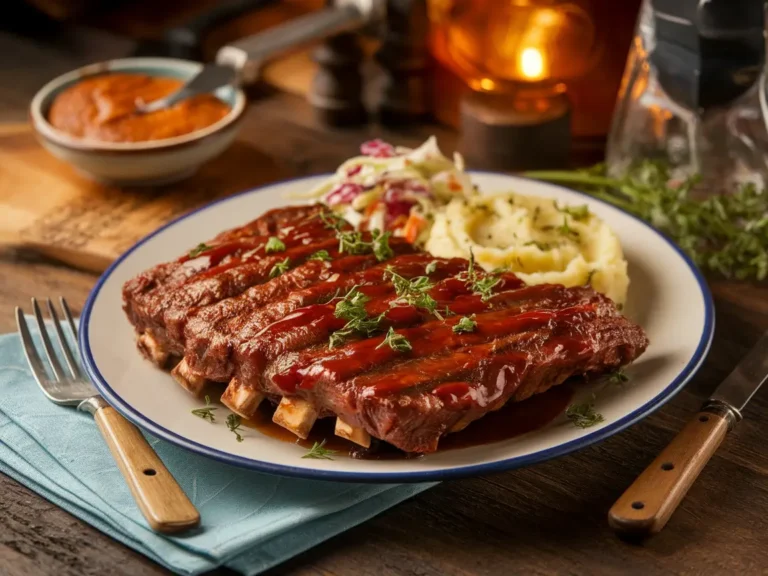If you’ve ever wondered whether the secret to tender country-style ribs lies in extended cooking, you’re not alone. These hearty cuts of meat are famous for their bold flavor, but getting them to the perfect level of tenderness can feel like a culinary puzzle. This guide will explore whether cooking time is the magic ingredient for melt-in-your-mouth ribs, and share insights into techniques, common mistakes, and ways to ensure perfect results.
Table of Contents
Understanding Country Style Ribs
What Are Country Style Ribs?
Country-style ribs are a deliciously meaty cut of pork or beef that isn’t technically from the rib section. These “ribs” are taken from the shoulder area of the animal, specifically the chuck primal for beef or the blade end of the pork loin for pork variants. They are hearty, thick cuts that resemble ribs but are meatier and often easier to prepare.
Characteristics of Country Style Ribs
- Rich Flavor: These cuts have a robust flavor thanks to their marbling and connective tissues.
- Bone-In or Boneless Options: Bone-in ribs may include parts of the shoulder blade, while boneless ribs are carved entirely from the meat near the shoulder.
- Versatility in Cooking: Suitable for grilling, braising, slow cooking, or even baking, they adapt beautifully to many techniques.
Differences Between Pork and Beef Country Style Ribs
Though they share a name, pork and beef country-style ribs differ significantly in flavor, texture, and cooking requirements:
- Pork Country-Style Ribs: Typically smaller and leaner, with a milder taste that absorbs marinades easily.
- Beef Country-Style Ribs: Larger, heartier, and richer in flavor, often requiring longer cooking times to achieve tenderness.
For example, pork ribs are often marinated for a few hours, while beef ribs benefit from slow-cooking methods that allow connective tissue to break down completely.
The Science of Meat Tenderness
Why Do Country Style Ribs Get Tender When Cooked Longer?
The secret to tender country-style ribs lies in their connective tissues, specifically collagen. Collagen is a tough protein found in meat that holds muscle fibers together. When cooked low and slow, collagen breaks down into gelatin, giving the meat a juicy and tender texture.
Collagen Breakdown Explained
At lower temperatures, collagen dissolves gradually, which is why longer cooking times are essential for cuts like country-style ribs. As the collagen transforms into gelatin:
- The ribs become more tender.
- Moisture is retained, preventing the meat from drying out.
However, if cooked too quickly or at high heat, collagen doesn’t have time to break down, leaving the meat tough and chewy.
Temperature’s Role in Tenderness
Cooking temperature is as important as cooking time. For collagen to properly break down:
- Maintain a low temperature between 190°F and 205°F (88°C to 96°C).
- Avoid exceeding these temperatures, as the meat may lose moisture and become stringy.
Juiciness vs. Overcooking
While long cooking times improve tenderness, there’s a fine line between tender and mushy. Overcooking ribs can break down muscle fibers too much, leading to a loss of structure. The key is to strike a balance low-and-slow cooking, combined with proper monitoring, ensures perfect results.
For scientific insights into collagen breakdown in meat, visit ScienceDirect’s Guide to Collagen.
Cooking Methods for Tender Ribs
Low-and-Slow Cooking: The Secret to Tender Ribs
The golden rule for tender country-style ribs is “low and slow.” Cooking at lower temperatures over extended periods allows collagen to break down while retaining moisture. Here are three of the most effective methods for achieving perfectly tender ribs:
1. Slow Cooking
Why It Works:
Slow cookers create the ideal environment for low, steady heat. The moist cooking method tenderizes the meat while locking in flavors.
Steps for Success:
- Season the ribs with your favorite dry rub or marinade.
- Place them in a slow cooker with a liquid base, such as beef broth or barbecue sauce.
- Cook on low for 6-8 hours until the ribs are tender and pull apart easily.
2. Grilling
Why It Works:
While grilling involves higher heat than slow cooking, using indirect heat ensures the ribs cook gently. A two-zone setup (hot and cool areas on the grill) works best.
Steps for Success:
- Preheat the grill and sear the ribs over direct heat for 2-3 minutes per side.
- Move the ribs to the cooler side, cover, and cook indirectly for 45 minutes to 1 hour, flipping occasionally.
- Optional: Baste with barbecue sauce in the final 10 minutes for a smoky, caramelized glaze.

3. Smoking
Why It Works:
Smoking combines low heat and flavorful wood smoke to tenderize the ribs while infusing them with a rich, smoky taste.
Steps for Success:
- Preheat the smoker to 225°F (107°C).
- Use wood chips like hickory or applewood for added flavor.
- Smoke the ribs for 4-6 hours, spritzing occasionally with apple cider vinegar to maintain moisture.
Comparing Methods: Which is Best?
| Method | Tenderness | Flavor Profile | Cooking Time |
|---|---|---|---|
| Slow Cooking | Excellent | Saucy and savory | 6-8 hours |
| Grilling | Good | Smoky and caramelized | ~1 hour (indirect) |
| Smoking | Outstanding | Deep, smoky, robust | 4-6 hours |
Each method offers unique benefits, but for ultimate tenderness, slow cooking and smoking are top choices.
Marinades and Rubs: Enhancing Tenderness
The Role of Marinades in Tenderizing Ribs
Marinades aren’t just about flavor they can also play a significant role in tenderizing country-style ribs. The acidic ingredients in marinades, like vinegar or citrus juice, break down tough muscle fibers, helping the meat become tender during cooking.
How Marinades Work:
Marinades penetrate the surface of the meat and work on the outer layers to soften muscle fibers. Ingredients like:
- Vinegar or Lemon Juice: Add acidity to tenderize.
- Soy Sauce: Contributes umami flavor while slightly breaking down proteins.
- Oil and Herbs: Keep the ribs moist and infuse them with aromatic flavors.
Quick Marinade Recipe for Tender Ribs:
- 1/4 cup soy sauce
- 2 tbsp olive oil
- 1 tbsp apple cider vinegar
- 2 tsp garlic powder
- 1 tsp smoked paprika
Combine ingredients, coat the ribs, and let them marinate in the fridge for 4-12 hours for best results.
How Dry Rubs Boost Flavor
While marinades focus on tenderizing, dry rubs are all about creating a flavorful crust. A well-balanced rub enhances the natural taste of the meat and forms a caramelized crust during cooking, locking in juices.
Dry Rub Essentials:
- Salt and Sugar: Balance flavor and aid in moisture retention.
- Spices and Herbs: Add complexity with paprika, black pepper, garlic powder, or cayenne.
- Optional Kick: Brown sugar adds sweetness, while chili powder brings heat.
Tip: Apply the rub generously and allow it to sit for at least an hour before cooking to let the flavors penetrate.
Marinade or Rub: Which Is Better?
Both methods have their strengths:
- Use a marinade for ribs that need extra tenderizing or flavor depth.
- Opt for a dry rub if you’re grilling or smoking and want a bold, crusty exterior.
For maximum impact, combine both! Marinate the ribs first, then apply a dry rub before cooking.

Common Mistakes and How to Avoid Them
Mistake 1: Overcooking or Undercooking the Ribs
Getting the cooking time right is crucial. Overcooking ribs can break down the fibers to the point of mushiness, while undercooking leaves the connective tissues intact, resulting in tough meat.
How to Avoid:
- Use a meat thermometer to monitor the internal temperature. For tender country-style ribs, aim for 190–205°F (88–96°C) for optimal collagen breakdown.
- Follow low-and-slow cooking methods to allow the meat to tenderize gradually.
Mistake 2: Skipping the Sear
Forgetting to sear the ribs before slow cooking or baking can leave them lacking that delicious crust and depth of flavor. Searing caramelizes the surface, locking in juices and adding a smoky, savory taste.
How to Avoid:
- Heat a skillet or grill to high heat and sear the ribs for 2-3 minutes per side before continuing with your chosen cooking method.
Mistake 3: Not Letting the Ribs Rest
Resting the ribs after cooking allows the juices to redistribute throughout the meat. Cutting into the ribs too soon causes the juices to escape, leaving the meat dry.
How to Avoid:
- Once the ribs are cooked, let them rest for at least 5-10 minutes before serving.
Mistake 4: Using Too Much or Too Little Seasoning
Under-seasoned ribs can taste bland, while over-seasoning can overpower the natural flavor of the meat. Balancing your marinades or rubs is key.
How to Avoid:
- Apply rubs generously, but avoid heavy-handed salting, which can dry out the meat.
Mistake 5: Rushing the Process
Cooking country-style ribs quickly at high temperatures doesn’t allow enough time for the connective tissues to break down, resulting in chewy meat.
How to Avoid:
- Always cook ribs over low heat for an extended period, whether using a slow cooker, smoker, or oven.
Learn more about safe cooking temperatures and tips at USDA Food Safety Guidelines.
Next, Part 6 will feature Frequently Asked Questions (FAQs) to address common queries about cooking and tenderizing country-style ribs.
Frequently Asked Questions (FAQs)
What are the best cooking temperatures for country-style ribs?
For tender, juicy country-style ribs, cooking temperatures are critical. Maintain:
- Low-and-Slow Methods: Between 190°F and 205°F (88°C to 96°C) for breaking down connective tissue.
- Grilling: Start with direct heat for searing (~450°F/232°C), then switch to indirect heat (~250°F/121°C) for slow cooking.
Using a meat thermometer ensures precise results.
How can I tell when my ribs are done?
You’ll know your country-style ribs are perfectly cooked when:
- The internal temperature reaches 195–205°F (90–96°C).
- The meat is fork-tender and easily pulls apart.
- A probe or skewer slides into the meat without resistance.
Is marinating necessary for tender ribs?
Marinating isn’t mandatory but can enhance tenderness and flavor, especially for tougher cuts. Marinades with acidic ingredients like vinegar or citrus juice help break down proteins, making the ribs softer. If you skip the marinade, a dry rub can still add plenty of flavor.
Should I cover the ribs while cooking?
Covering helps retain moisture, particularly during slow cooking or oven roasting. For example:
- Use foil or a lid during the initial cooking phase to prevent drying out.
- Uncover in the final stages for a crispy or caramelized surface.
How long should I rest the ribs after cooking?
Resting is essential to let the juices redistribute throughout the meat. Allow your ribs to rest for at least 5-10 minutes before cutting or serving. This step ensures every bite is moist and flavorful.
Can I make ribs tender without a smoker or slow cooker?
Absolutely! The oven is an excellent alternative for tender ribs. Bake at 275°F (135°C) in a covered dish with a bit of liquid for 2-3 hours, then uncover for the last 30 minutes for a crispy finish.
What should I do if my ribs turn out dry?
If your ribs are dry, try these fixes:
- Add Moisture: Brush with barbecue sauce or baste with broth before reheating.
- Shred and Repurpose: Use the meat in tacos, sandwiches, or soups for a second life.
Conclusion
Key Takeaways for Tender Country-Style Ribs
Country-style ribs are a deliciously hearty cut that rewards patience and proper technique. Whether you’re using a slow cooker, grill, smoker, or oven, the secret lies in cooking them low and slow to allow the collagen to break down, creating tender, juicy meat. By understanding how cooking temperature, time, and preparation methods like marinades and rubs affect the texture, you can transform these ribs into a show-stopping dish.
Final Tips for Success
- Monitor Temperature: Keep your cooking temperature between 190°F and 205°F for optimal collagen breakdown.
- Balance Flavors: Use marinades or rubs to enhance the natural taste of the ribs.
- Rest the Meat: Letting the ribs rest for 5-10 minutes ensures juices redistribute evenly for moist, flavorful results.
- Experiment with Methods: Slow cooking and smoking are excellent for tenderness, but don’t overlook grilling or oven roasting for their unique flavor profiles.
Country-style ribs are versatile, forgiving, and packed with flavor, making them a perfect choice for any occasion. With the right preparation and patience, you’ll enjoy a plate of tender, melt-in-your-mouth ribs that everyone will rave about. So, fire up your smoker or slow cooker, and get ready to create something truly delicious!
Thank you for reading this comprehensive guide to perfectly tender country-style ribs. Now it’s your turn to try these techniques and savor the results!

